Cries and Whispers, 1972, written and directed by Ingmar Bergman.
In Harold Pinter's marvelous play Moonlight, a woman tells her terminally ill husband, "Death will be your new horizon." It's the most quietly chilling sentence I know, and it would have made the perfect epigraph for Cries and Whispers. The film is concerned with the business of dying, and not in an abstract way. Harriet Andersson plays Agnes, a woman who is rapidly losing a battle with cancer, and for the first forty-five minutes Bergman mostly makes us watch her die. Her performance reminds you just how much the movies have always lied to us about death: Agnes doesn't have one of those terminal disease where you have a touching final conversation, then drift off to sleep as flights of angels sing you to your rest. She's clearly aware that her body is destroying itself from the inside, and her performance lets you know exactly what that must feel like.

Her battle has nothing in common with a chess game. Agnes is attended by her two sisters, Maria (Liv Ullmann) and Karin (Ingrid Thulin), as well as her live-in maid, Anna. Here they all are, in one of Sven Nykvist's typically soothing compositions:

Nykvist uses that jarring, intestinal red throughout the film, starting with the opening titles.

Never underestimate the cumulative effect of an unsettling palette that unsettling. Even without the colors, and even if you got rid of Agnes entirely, Cries and Whispers wouldn't exactly be a cakewalk, because Maria and Karin are so miserable to watch. What, you thought this was going to be a Bergman film where familial relations weren't a swamp of guilt and sorrow? Maria's flagrant affair with a man who despises her drives her husband to attempt suicide, Karin mutilates herself to avoid sex with her husband. And they don't much like each other either. As in Autumn Sonata, their conversations range from landmined to openly hostile. And neither one is willing or able to deal with the exigencies of Agnes's dying. The only person who is at all capable of comforting Agnes is her maid, Anna. It's possible they were lovers; at the very least, their relationship is deeper than is typical for an employer and employee. Kari Sylwan plays Anna as the milky-skinned embodiment of selfless, maternal love.
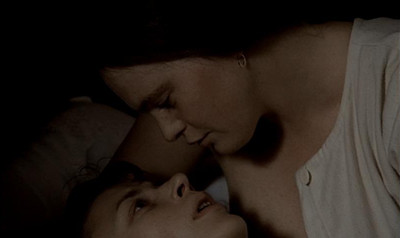
So it's completely appropriate that when Agnes asks for one last act of affection, Bergman quotes the most famous image of maternal love in Western civilization.
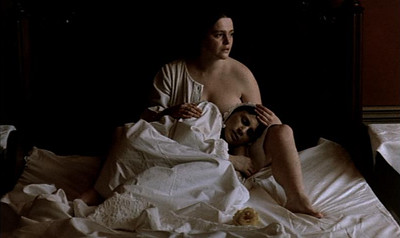
You can see in that shot just how painterly Sven Nykvist's cinematography is throughout. The formal, staged, quality of the film's compositions is the only thing that makes the intense on-screen suffering at all watchable; along with the period costumes, it distances the viewers a little from Agnes's pain. A little, not a lot. There's a lengthy shot of Agnes laboring to breathe that is the stuff of nightmares. Speaking of nightmares, Cries and Whispers has a nightmare sequence that, once again, establishes Bergman as the best horror director never to direct a horror film. Sometimes shallow focus can be terrifying.

The film's structure is intensely formalized: between scenes of Agnes's death and its aftermath, we get a flashback or dream sequence focused on each of the four main characters. Except for Agnes's flashback, each begins with a closeup of the character's face, strongly lit on one side.
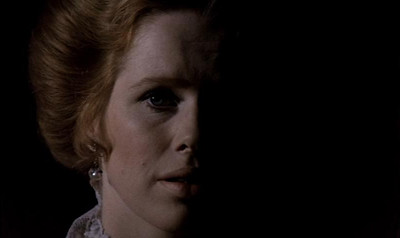
And each ends with a similar closeup, lit from the other side.
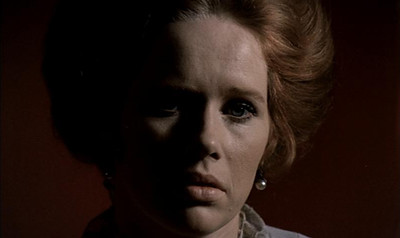
Bergman and Nykvist abstract the actors' faces into something lunar and alien, but by the end of each flashback, we know some of the damage behind their eyes. But only some of it. There's an emblematic scene shortly before Anna's death where, in obvious pain, she tries again and again to throw up into a basin.
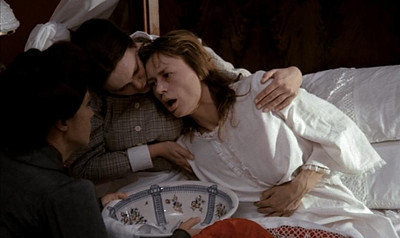
No matter how hard she hacks, spits, and heaves, she can't get anything to come up. That's part of what Cries and Whispers is about, something we all know to be true but don't like to think about. The thing that will kill us is the thing we can't get out, the poison in the wound. All we can do is tire ourselves out. And yet that's not everything Cries and Whispers tells us. For all the film's relentless interiority, Bergman ends with a passage from Agnes's diary about a day she was feeling well enough to venture outside with Anna and her sisters.

She writes:
I wanted to hold the moment fast, and thought: "Come what may, this is happiness. I cannot wish for anything better. Now, for a few minutes, I can experience perfection."
Our glory is that we can experience perfection, if only for a few minutes. Our tragedy is that we recognize—even as it's happening—that it's only for a few minutes. The poison is in the wound.
Randoms
- The film ends with an untranslated intertitle:
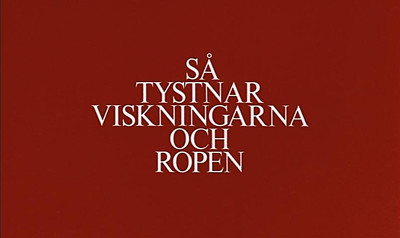
- From what I can tell from googling, it means, "So the cries and whispers become silent." Is that more or less correct, hive mind? Any idea why it wasn't subtitled?
- The DVD features an interview that Bergman gave along with actor Erland Josephson, which makes him seem like he must have been rather horrible to know in his personal life. Both he and Josephson are remarkably blithe about having mistreated women and been awful fathers, although they're certainly charming in an "incorrigible grandpa" sort of way. I did like one of Bergman's stories: unhappy with the negative reviews a particular critic was giving his work, he apparently cold-cocked him because he knew the critic's newspaper could no longer allow him to review Bergman's work after a public altercation. Diabolical.


24 comments:
I don't know if it's the color scheme or the performances, but something in this movie resonates very deeply with me. I hesitate to say it's my favorite, but . . . I consider it in the top two.
I mean, grim as it is, it's just so beautiful - Nykvist certainly earned his name (and Oscar!) with this one.
I also have to say Liv Ullman's kissing/biting the dude's finger is among the most erotic single takes in cinema, and it's typically perverse/brilliant of Bergman to frame it against Ingrid Thulin's Haneke-style mutilations. Which isn't the best thought to end this comment on, but . . . keep up the good work!
Watched this years ago, need to watch it again. Excellent writeup.
Bergman actually did do at least one 'straight up' horror film in the form of Hour of the Wolf (think Polanski). Virgin Spring also got remade as Last House on the Left though it probably doesn't count.
I've added "Hour of the Wolf" to my queue -- I have high hopes for this. Thanks for the tip!
Le Ted,
Ulmann's scenes with the doctor are pretty spectacular -- his monologue when he makes her look in the mirror is amazing. I didn't find their scenes together particularly erotic, mostly because he seems so indifferent to her--but she's definitely amazing. What's the other film in your top two?
I've been looking forward to this one. Your review was great, if a little short. To be honest, I'm surprised you didn't talk more about the Dostoevsky-style symmetry, given your writing background. I was very curious about what you'd think of the scene where Karin and Agnes connect to Bach.
Save a little disappointment and avoid stratospheric expectations for Hour of the Wolf. Not that it isn't worth seeing. There are a lot of great things about it, and it has my single favorite shot from any Bergman. But it isn't one of the really great ones. Persona, Smiles of a Summer Night, Winter Light, Wild Strawberries, and Scenes From a Marriage (full episodic version) are way more essential.
Cheers!
Matt,
Of all the films that I've watched as part of my own criterion survey, this was the one that stuck with me the most. I couldn't stop thinking about it for days afterward. The images and the torment these characters are put through just isn't easily shaken off.
I thought your review was very insightful, but I reread it trying to figure out whether you actually liked the film. It's clear you respected it.
This, along with Fanny and Alexander, are my two favorite Bergman films. And this one is more devastating.
Another point that I find important is the film's claustrophobia. Aside from the opening and closing, we're inside those red rooms through the entire film, as if we're stuck inside a cancerous body.
I have been reading your work here for a while but I have been waiting to see what you would say about this truly amazing film. Le Ted said it right, there is something that just resonates with me in this film.
I chose to watch it for a paper I wrote in a film class (along with the amazing Through a Glass Darkly and Wild Strawberries) and after watching it once I had to see it again. By the end of the weekend I had watched it about 5 times. I was entranced by it, the way the colors stood glaringly apart from each other like the sisters, the magnificent dialogue, the beauty of the shots. This is my second favorite film and Bergman is my favorite director, becoming so after this film. His work here, Persona, and the Silence of God trilogy (Through a Glass Darkly, Winter Light, and The Silence) are among the greatest works I have ever experienced.
So, in other words, I am glad you watched and seem to have connected to it. A film that I tell people to watch, but usually after they have seen some other Bergman because this is a daunting and painful film, but an infinitely powerful one.
Vadim,
Do you mean the structural symmetry, the flashback-flashback-death-flashback-dream thing? Or is there a symmetry I missed? As far as the "connect to Bach" scene--I really was not sure how to take it, whether it was meant to be sincere or not. What I did like, but didn't write about, was the way that Maria uses kindness as a weapon in the scenes leading up to it (especially when she insists on touching Karin) But what do you think of the Bach scene?
Mark,
Respect is a better word than "like" for this one, yeah. I think it does what it sets out to do masterfully, but when I think of movies I've "liked," I tend to think of hangout movies, not films that put you through the wringer. Let's put it this way: I won't forget this movie, but I'm not anxious to see it again soon, either.
Jeffrey,
Yep, except for the exterior establishing shots at the beginning and the flashback at the very end, we're stuck in that awful house—even when it doesn't make sense, like having the priest speak inside isntead of at a grave. Of course, that makes the flashback at the end all the more idyllic.
Daren,
Glad you're enjoying the blog. For me, Andrei Rublev is the fiilm that resonates beyond all reason. I think if I were to watch Cries and Whispers five times in a row over a weekend, I'd jump off a bridge--it is, as you say, a painful movie. But also hypnotic and beautiful and amazing.
As usual, excellent review. One thing I noted from your stills.
"Bergman and Nykvist abstract the actors' faces into something lunar and alien, but by the end of each flashback, we know some of the damage behind their eyes."
It's interesting how these two shots play with our expectations of lighting. In traditional three-point lighting, the brighter key light shines on the side of an actress' face away from the camera, with the fill light used on the side of the face more directly facing the camera. (See any conversation scene in any Hollywood movie ever). I love how the unusual use of key lighting on the left side of her face is used to distance the audience in the first shot, and how much more we relate to the second shot through the use of a more typical, comfortable lighting situation.
Yes, I was disturbed by this film for a long time after I saw it. I'm convinced that no one does bitchy, dysfunctional, passive-aggressive families as well as Bergman.
I like this film and The Silence because it is about sisters and Autumn Sonata because it is about a mother/daughter. Ingrid Bergman gave a great performance in it.
I was referring to what can be called the three “character sequences,” each of which opens and closes with a red close-up shot (ie: your formalized structure thing). Here is my take on the significance of these three sequences:
Each of the character sequences is ultimately a theatrical implausibility, and I think they’re like that for a reason. What the review calls the dream sequence is obviously fantasy. In other words, it’s not part of the story so much as a piece of exposition. As for the flashbacks, each contains an incredibly implausible event. The husband’s suicide attempt feels like cheap melodrama, and Karin’s act in the dressing room is simply too over-the-top. How credible is it that both Maria and Karin are still with their husbands? These two events are nearly as difficult to reconcile with the main narrative as the events of the dream sequence, where the dead come back to life. So I don’t think the “flashback sequences” should be understood as such. A flashback is an event from before the present action, whereas these events aren’t convincing enough to fit within the plot. Likewise, I’m not sure that the “dream sequence” really is a dream sequence, because there’s little to separate it from what you call the flashback sequences, and little to indicate that it’s literally the dream of any particular character.
Read together, the three character sequences suggest something else: Bergman is telling us a story that is driven by a physical ailment and by the actions of three characters, so he wants to develop the characters, but he also wants to avoid burdening the story with a lot of exposition. I think he finds an elegant solution by having these bracketed instances of cinematic fantasy that he intersperses throughout a clear and rational narrative. Each character sequences gets at the heart of its subject character. Under this reading, they present a separate theatrical reality, a sort of additional reality, which doesn’t actually connect to the plot, but that informs how we understand it.
Bergman’s films are sometimes flawed by how much they try to achieve through exposition. Autumn Sonata is a very good film, but I think it suffers from that problem. If you buy into my reading, Cries & Whispers manages to have its cake and eat it too. That’s part of why I think it’s his best work.
I’m not sure what exactly to think of the Bach scene, but here’s a theory: it revisits a theme that was presented by a scene from The Silence. In the scene two sisters who are otherwise profoundly different manage to both like a piece by Bach. The Cries & Whispers scene might be a sort of mature revisiting of this theme that music (or at least Bach’s music) can universally connect humanity. The later scene is fundamentally cynical, because we sort of know ahead of time that Maria is full of shit and that Karin shouldn’t trust her. Reading it as a cynical update could explain the lack of dialogue. But I’m not completely convinced that this is the way it should be read. It might have just been a stylistic flourish.
I found some support for the idea that none of the character sequences are actually part of the reality in which most of the film takes place. In a letter that Bergman wrote to the cast before shooting, he included a synopsis of the four characters. Here's what he had to say about Karin:
"KARIN, her [Agnes's] 2-years-older sister, made a wealthy marriage and moved to another part of the country. She soon recognized that her marriage was a mistake. Her husband, who is 20 years older, is physically and psychologically repulsive to her. She is mother to five children, but nevertheless seems untouched by motherhood and marital boredom. She presents an impeccable façade and is regarded as haughty, distant. Her loyalty to her marriage is unshakable. Deep beneath a veneer of self-control, she conceals an impotent hatred of her husband and a continuing rage against life. Her anxiety and desperation never come forth except in her dreams, which every now and then torment her. In the midst of this tumult of bridled fury, she carries within herself a talent for dedication and intimacy and a longing for closeness. This enormous resource lies immovably enclosed and unused."
It doesn't seem like Bergman conceptualized these sequences as "real" anymore than several of the sequences in Persona or Hour of the Wolf. Philip Strick's essay observes: "It has theatrical resonances, but the situation assumes Bergman's usual cinematic complexity by the simplest means–the flashback which we can believe or not as we please"
Bergman's letter comes from published excerpts of a diary written by someone who was on the set while they were filming. It's a pretty good read and has some very funny parts if anyone's interested. http://bergmanorama.webs.com/films/cries_and_whispers_diary.htm
Vadim,
That's fascinating, and you've convinced me, at least when it comes to Karin's flashback. But Maria's dream sequence seems to take place at a particular time and contains some events that clearly *did* happen -- her affair with the doctor, right? She says something along the lines of "It's been so long," when she meets him, and the narration puts that a specific time and place. Or do you take that to be fantasy/altered version of events as well?
Since no other Swedes seem to have commented, I just wanted to confirm that you Google translation is correct.
I like to read the film, especially given the film's conclusion, as a framing of all that came before it as completely and utterly absurd. In this sense, it is an existential comedy rooted in the existential tradition of accepting death and very much highlighting the absurd ways in which people are able to play out their own existences. For all I can remember, the only person who can find any pleasure in the film is the one who is surely in the most distress. Does it not seem crazy that the other sisters make so much a mess of their lives when they have such opportunity to find enjoyment, free from the terror of their sister's illness. This contrast between real, physical suffering and their petty self-induced sufferings is highlighted throughout the film (there is never a second where you forget the presence of Harriet's character), but it comes to a head in the completely asynchronous coda of her expression of happiness over such a small, insignificant moment. If you ever want to put your own perceived sufferings in context and remind yourself to enjoy the simple things in life, what better film than this? For that reason I think this is truly a film you can like, not for the experience of watching it on a good day, but for the rewards of giving you the perspective to enjoy the following days. And that is one of the greatest gifts of rich art: it pervades our thoughts and attitudes long after its immediate effects have passed rather than just simply pacifying our own petty troubles until the picture fades.
Sorry it took me so long to respond; I had to find time to rewatch the movie for the umpteenth time to check what you said against what I remembered.
Basically I think your point shoots a big (though not fatal) hole in my theory. I would still argue that the actual events of the cinematic interlude are at most a semi-real dramatization. But obviously it's harder to make that argument sound convincing when at least half of what I call a fictional scene (the affair) apparently happened in some way or another. I guess the better answer would be to say that narrative reality and narrative fiction flow together in this movie, and that it's nearly impossible and/or unnecessary to give each scene a solid classification.
I guess what I'm saying is, you made a great point and I can't stick to my guns completely, but that the gist of what I was originally saying still stands, which is that Bergman fucks with reality as a way of getting around the exposition problem.
Lastly, LEAVES comes off a little strongly, but his basic point is one that I wanted to make but lazed out of trying to articulate. Your emphasis on how unpleasant it is to watch this film sort of misses the point for me. Formal virtuosity aside, the pleasure it instills is the pleasure of Dostoevsky, who isn't read for immediate satisfaction so much as for valuable life perspective. Several of Bergman's movies are some of the best I've ever seen at putting a few characters in a situation that I end up referring to when I'm having similar problems. If that makes it sound like an endorsement for a self-help book, then so be it. But given your adoration of Andrei Rublev (which is one of my two or three favorite films), I suspect that you sometimes disregard the pain of experiencing great art for the value it can bring.
Jonas,
Thanks!
Vlad,
I'll agree to call it "a film where the lines between fact and fiction are blurred" if you will. Re: the unpleasantness vs. formal virtuosity -- I think that pleasure is an undervalued cinematic virtue, over here on the Criterion Collection watching side of the aisle (Hollywood, of course, cares about nothing else). Something I've been mulling over. I will say that I found Andrei Rublev cathartic in a way Cries & Whispers wasn't (for me) -- beyond any formal virtuosity. The bell sequence gets to me every time I see it.
Cries and Whispers was made shortly after Bergman completed his sequence of deconstructionist films shot on the island of Faro (Persona, Hour of the Wolf, Shame, and The Passion of Anna) and shares a few characteristics with them. All of these films transition between scenes that explicitly cannot be objectively real and other scenes that might; all use isolated settings to force characters into states of psychological warfare; all star Liv Ullmann.
The Faro films are all explicitly artificial. They are constructed around Brechtian distancing devices and tend to feature characters who may be considered aspects of a single personality. They are all discomfortingly autobiographical.
While Cries and Whispers is not constructed around a distancing device, it is overtly symbolic and surreal. While it is not explicitly autobiographical, it concentrates on themes of primary concern to Bergman throughout his "classical" period and trilogy: mortality and faith. And while its characters are not as transparently similar to Bergman as those in the Faro films, they nevertheless seem to be aspects of one complex persona. What Bergman achieves in this film is a synthesis of his entire mature body of work leading up to this point.
I say this because I don't think that any of Cries and Whispers is meant to be read as objectively "real." From the blood-colored house to the "dream" sequence of Agnes's resurrection or undead state, there is never any indication that the film takes place in material reality. For this reason, I have always read the "dream sequence" as continuous with the "plot" of the film. Agnes could not be resurrected in the real world, but this is no more or less likely than that a blood-colored house should be occupied by an all-female family whose members fantasize gender violence. Cries and Whispers is, in my opinion, Bergman's best film and possibly the greatest film ever made. But I don't think a frame of it is intended to take place in the world Bergman lived in.
Post a Comment